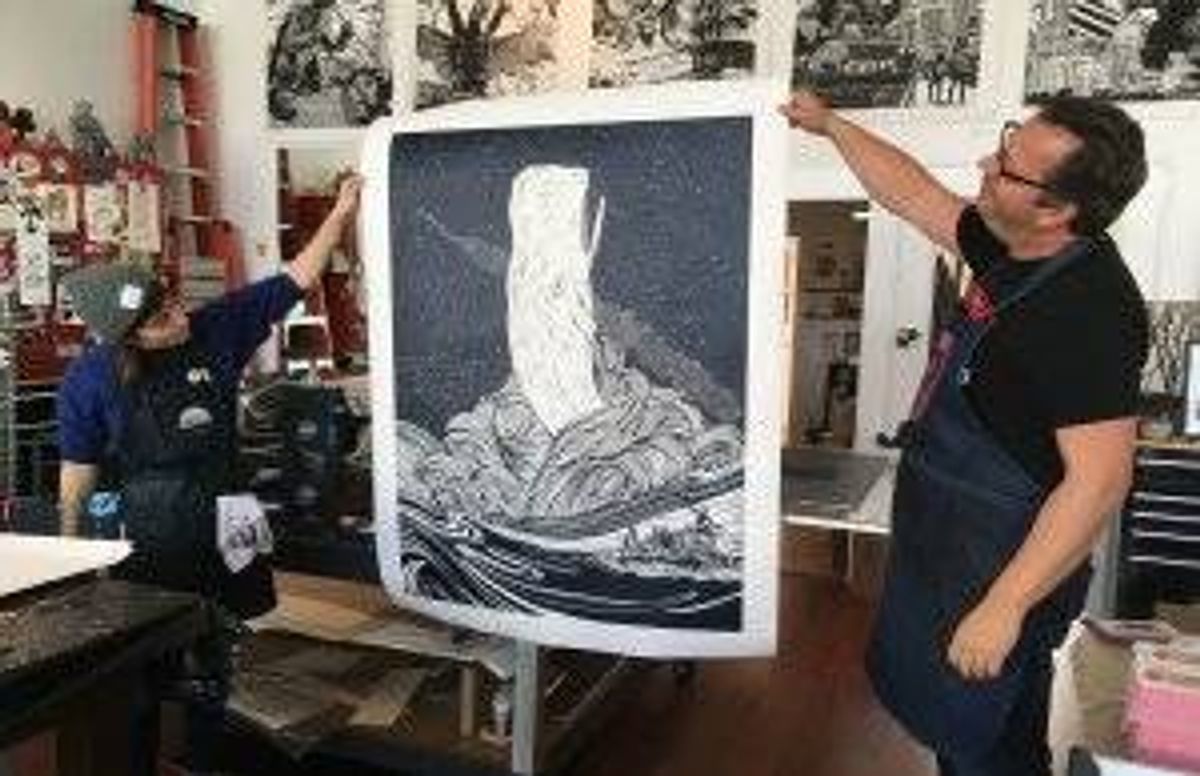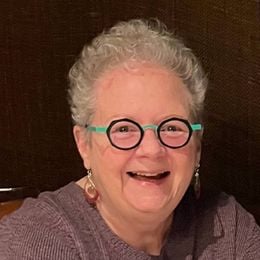The Satisfying Art of Printmaking
This intriguing creative pursuit resists perfection
Printmaking isn’t where Eric Rewitzer started in art, but for over a decade it has been his primary practice, and today he teaches it, too. “At one time, carving blocks of linoleum seemed like a crazy way of making art and I was a little suspicious of it,” Rewitzer says. “Now I find it so satisfying to see the fruits of my labor in a piece of art.”

Rewitzer’s linocut prints cover the walls at 3 Fish Studios, his workspace and gallery in San Francisco’s Outer Sunset neighborhood. On display are his intricate interpretations of a majestic cypress, the Golden Gate Bridge, Godzilla, a giant sequoia, Yosemite's Half Dome and a stand of trees. Here too are works by painter Annie Galvin, Rewitzer’s wife and business partner. Both are 52.
On one wall hangs a new 36” x 48” woodcut print of Moby Dick rising up from the waves, a new image Rewitzer designed in collaboration with artist Linda Fahey and then cut. How long did it take? “A lifetime,” Rewitzer says, laughing.
“Linda’s signature is waves, and we’ve been talking about doing Moby Dick for months,” Rewitzer says. “The feel of the chisel moving across the wood is a feeling people have experienced throughout history, and there is so much satisfaction in working with your hands. Too often, that has become lost in the modern world.”
Beginners and Advanced Students Welcome at Classes
What was lost can be found in printmaking classes. (To find one check with art schools, galleries and printmakers near you.) Rewitzer and Galvin opened their studio in 2006 and started offering classes in 2008.

Since then, thousands of students have enrolled, ranging from their late teens to their 70s. Currently, Rewitzer teaches the advanced classes and Orlie Kapitulnik, a printmaker at the studio, teaches classes for beginners. Both classes meet for two sessions.
“We start by breaking habits,” says Kapitulnik. “Printmaking is not as obvious as drawing or painting, and it takes a lot of patience.” All participants are invited to bring in an image that appeals to them and learn how to transfer the image. Next, they learn about the tools of this trade: the knives, spades and wedges. (The idea of handling those tools has stopped me from signing up for a class. I have limited grip strength, or I’d be there.)
Students then learn how to carve their selected image onto a linoleum block, which is made from ground cork mixed with linseed oil and bonded to burlap. They practice for a bit. And then, armed with plenty of moral support from Kapitulnik, students take home their blocks and tools to complete the carving.
At the second class, it’s time to ink the press and start making prints. “Working with the press extends the tactile experience,” Rewitzer says. “With even ink coverage, you get the best possible result, one that brings the image to life.” Students may try different colors, different papers and different inking techniques.
‘Mistakes Make the Work Human’
“There are so many ways to change the nature of a print, and this part of the process emphasizes the experimental nature, the creativity, of all the work we do in our shop,” Rewitzer says. “When people can’t let go of an attachment to perfection, I remind them that printmaking resists perfection. Mistakes make the work human, give it soul.”
Rewitzer and Kapitulnik agree that even with mistakes, most participants are pleased with their prints. “After the first print is made, you see that spark, that sense of satisfaction, even in people who came to class unsure about their carved design,” Rewitzer says. “And that’s why we do this.”

June Oberdorfer, a geology professor at San Jose State University, has taken printmaking classes because she believes in doing things outside her comfort zone. “I’m a geologist, so my artistic level is not high, but I have always dabbled in art because it’s a great thing to do,” she says.
Oberdorfer, 69, first took a beginning printmaking class at 3 Fish Studios three years ago. She just completed an advanced class in November. At the first class, Oberdorfer made a small linocut based on a photograph of an old Roman road she saw during a trip to Portugal. At Christmas that year, Oberdorfer gave prints to the people she had hiked with on the trip.
This year, Oberdorfer carved two 8.5” x 11” blocks, replicating an image from Iceland where the Mid-Atlantic Ridge is pulling apart a valley. The two-part printing process rendered her image in color, with reddish-brown rocks and blue water.
‘Printmaking Changes How You Look at the World’
“I’ve always liked Japanese block prints and high-contrast art. This process distills an image to its essence, and that’s really satisfying,” Oberdorfer says. “Plus, when you’ve been exposed to it, printmaking changes how you look at the world around you.”
The arts have changed the lives of many Next Avenue readers, and printmaking certainly changed Rewitzer’s. Though he was interested in art as a young man, Rewitzer made a detour into a career in software. In 2007, when he decided to become a full-time artist, Rewitzer signed up for a printmaking class at City College, though it had been over a decade since he had wielded a carving tool.
“I wanted to refamiliarize myself with it, learn about the current materials in use. That class narrowed my focus. Now, I love the carving, the inking, the graphic quality — all of it,” he says.
What inspires him? “The beauty and the diversity of the California landscape, the natural world.” His linocut of a roaring bear, carved two years ago, is viewed as a symbol of the Golden State's fighting spirit and was featured in Time magazine. Currently, Rewitzer is working on a series depicting different trees in Golden Gate Park.
After carving Moby Dick on wood, Rewitzer says now his focus may be shifting. “I may be migrating toward woodcuts, taking up a new challenge,” he says. “I’ve gotten good at carving linoleum. I can only get better at wood.”


